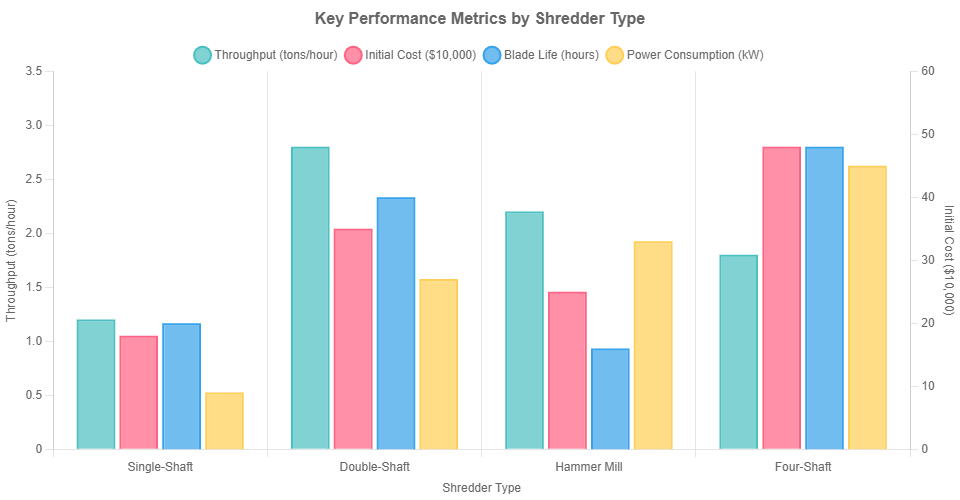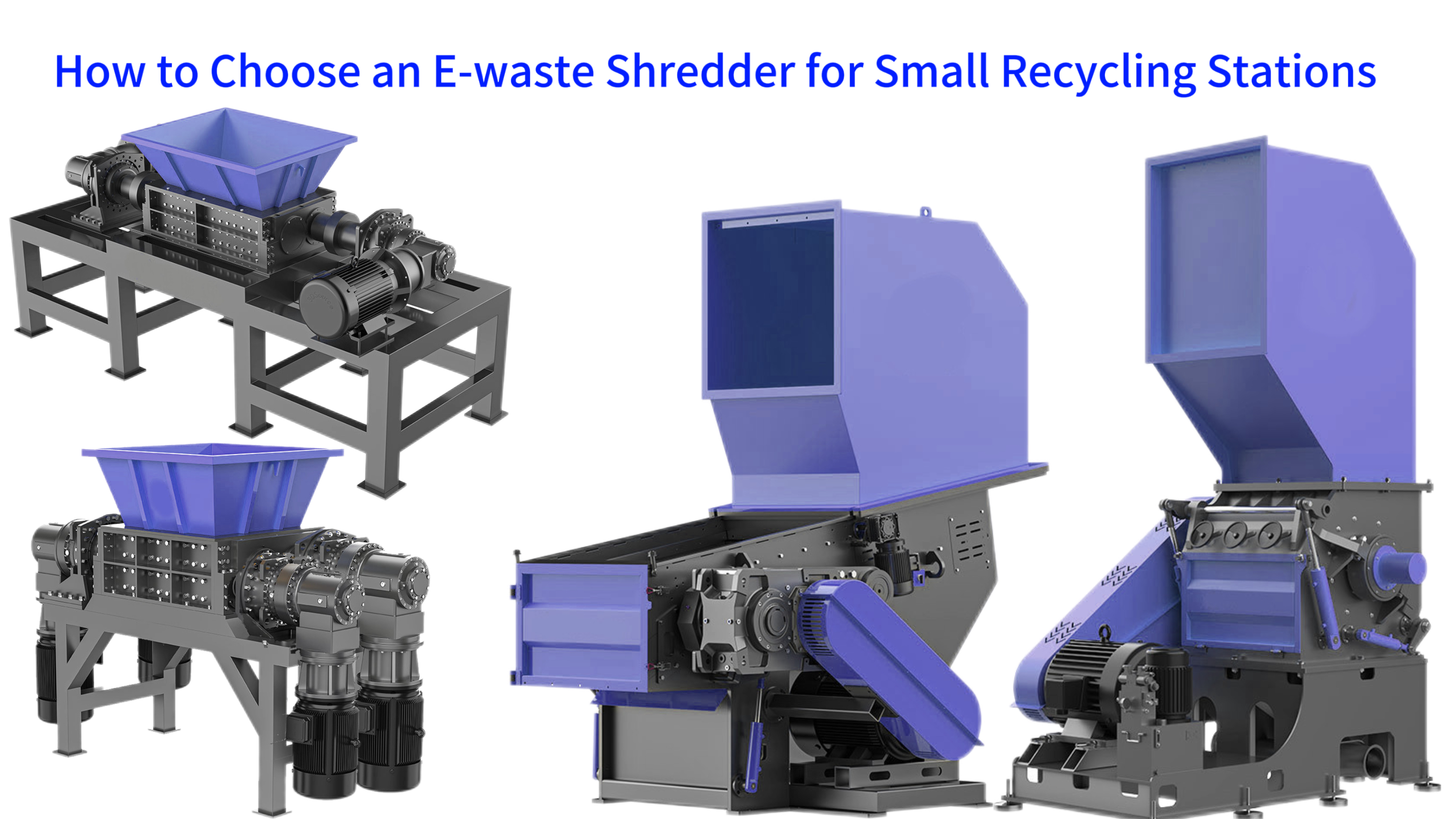Selecting the right e-waste shredder is crucial for small recycling operations to process electronic scrap efficiently and safely. This industrial equipment uses shear and tear forces to break down discarded electronics into smaller fragments, facilitating material recovery and data destruction. Unlike office shredders, industrial e-waste shredders handle diverse materials from circuit boards to metal casings with robust cutting mechanisms. The selection process requires careful consideration of space constraints, throughput requirements, and compliance standards to ensure optimal operation within limited budgets.
Understanding the Unique Needs of Small Recycling Stations
Small recycling stations operate with distinct constraints that significantly influence equipment selection. Limited floor space often restricts machinery footprint to under 20 square meters, while budget considerations require balancing initial investment with operational costs. Throughput requirements typically range from 500kg to 3 tons per hour, with frequent fluctuations due to seasonal variations in e-waste collection. Material diversity presents another challenge, as small stations must process everything from smartphones to computer servers without dedicated preprocessing equipment.
Evaluating Daily Throughput and Peak Load
Accurate capacity planning begins with analyzing historical intake data from the past 12-24 months. Most small stations find their average daily processing volume falls between 1.2 and 2.5 metric tons, with peak periods exceeding these values by 40-60%. Industry experts recommend incorporating a 25% capacity buffer to accommodate unexpected volume surges and future growth. This proactive approach prevents bottlenecks during high-volume periods while maintaining efficient operation during normal cycles.
Multi-Material Compatibility Requirements
Modern e-waste streams contain over 15 different material types requiring specialized processing approaches. Mixed electronic scrap typically contains 40-50% plastics, 20-30% metals, and 5-10% circuit boards by weight. Equipment must handle size variations from small USB devices (under 100g) to large servers exceeding 30kg. Special consideration must be given to components containing batteries or capacitors, which require anti-sparking designs and specialized discharge mechanisms for safe processing.
Key Technical Parameters of E-Waste Shredders
Technical specifications determine the operational efficiency and safety compliance of e-waste processing equipment. Particle size control ranges from coarse 50mm fragments for initial size reduction to fine 5mm particles for material liberation. Advanced systems incorporate integrated separation technologies including overband magnets recovering 98% of ferrous metals and eddy current separators capturing 90% of non-ferrous materials. Noise emissions must comply with workplace safety standards, typically operating below 85 decibels with proper acoustic enclosures.
Blade Material and Lifecycle Considerations
Cutting tools represent the most critical wear components in e-waste shredders. Tungsten carbide blades maintain sharpness for 800-1,200 operating hours compared to 300-500 hours for standard high-speed steel alternatives. Advanced systems feature automatic sharpening mechanisms that extend blade life by 40% through regular maintenance cycles. The total cost of ownership must include replacement blade sets ranging from $2,000-$8,000 depending on machine size and material specifications.
Power System Configuration
Motor selection directly impacts energy consumption and operational reliability. Modern shredders utilize IE4 premium efficiency motors reducing electricity usage by 15-20% compared to standard models. Power ratings range from 15kW for basic single-shaft units to 75kW for heavy-duty dual-shaft systems. Variable frequency drives provide soft-start capabilities reducing mechanical stress while allowing torque adjustment based on material density. These systems typically operate at 20-40 RPM for high-torque applications requiring maximum tearing force.

Comparative Analysis of Main E-Waste Shredder Types
Different shredder architectures offer distinct advantages for specific e-waste processing applications. Single-shaft systems provide cost-effective solutions for preliminary size reduction, while twin-shaft models deliver superior tearing force for mixed electronic waste. Hammer mill configurations excel at brittle material processing but struggle with ductile metals. Mobile shredding units offer flexibility for multi-site operations but sacrifice throughput capacity compared to stationary installations.
Double-Shaft Shredder Solutions
Twin-shaft shredders utilize counter-rotating cutters that generate tremendous shear forces ideal for breaking down electronic cabinets and large appliances. These systems operate at low rotational speeds (15-30 RPM) while producing high torque outputs exceeding 20,000 Nm. The intermeshing cutting discs create a pulling effect that automatically feeds material without additional conveyors. Modern designs incorporate hydraulic adjustable screen meshes that control output size from 30mm to 100mm without tool changes.
Four-Shaft Shredding Systems
Quad-shaft configurations provide superior processing precision for specialized applications requiring fine output sizes below 10mm. These systems integrate primary shredding and secondary granulation stages within a single unit, reducing material handling requirements. Advanced models feature integrated eddy current separation modules that automatically remove non-ferrous metals during the shredding process. This configuration proves particularly effective for printed circuit board processing where material liberation requires particle sizes under 5mm.
Safety and Environmental Compliance Requirements
Regulatory compliance forms a critical aspect of e-waste processing operations. International safety certifications including CE marking and UL certification ensure electrical and mechanical safety standards are met. Dust explosion protection requires ATEX-compliant designs with spark detection and suppression systems. Environmental directives including ROHS and WEEE dictate material handling procedures and documentation requirements for hazardous substance management throughout the shredding process.
Dust Collection System Configuration
Effective dust control requires multi-stage filtration systems capturing particulate matter down to 0.3 microns. Negative pressure designs contain dust within the processing chamber while HEPA filters achieve 99.97% filtration efficiency. Industrial dust extraction systems typically handle air volumes of 3,000-5,000 m³/hour with automatic filter cleaning mechanisms. Regular maintenance protocols require filter replacement every 400-600 operating hours depending on material composition and moisture content.
Data Security Destruction Standards
Information security requirements follow international standards DIN 66399 which specifies six security levels based on particle surface area. Level P-4 security requires particle dimensions under 10mm² for confidential data destruction, while P-7 standards demand particles under 0.8mm² for top-secret materials. Integrated degaussing systems generate magnetic fields exceeding 10,000 oersteds to completely erase magnetic storage media. These systems typically process 150-200 hard drives per hour while providing destruction certificates for compliance auditing.
Maintenance and Operational Cost Optimization
Lifecycle cost management significantly impacts the financial viability of e-waste processing operations. Wear part replacement typically constitutes 35-45% of operational expenses, with cutting elements requiring the most frequent attention. Smart monitoring systems utilize vibration analysis and thermal imaging to predict maintenance needs before failures occur. Strategic spare parts inventory should include enough components for 2-3 months of operation based on manufacturer recommendations and usage patterns.
Preventive Maintenance Planning
Proactive maintenance schedules reduce unplanned downtime by 60-70% compared to reactive approaches. Automated lubrication systems deliver precise grease quantities to bearing points every 8-12 operating hours. Blade wear monitoring uses laser measurement systems detecting dimensional changes as small as 0.1mm. Remote diagnostics capabilities allow technical specialists to analyze equipment performance from off-site locations, often resolving issues without physical visits. These systems typically pay for themselves within 14-18 months through reduced service costs and improved availability.
Residue Processing Solutions
Post-shredding material separation determines the ultimate value recovery from e-waste streams. Advanced separation systems achieve 95-98% purity for recovered metals through combined magnetic separation and eddy current separation. Non-metallic fractions often undergo further processing for use as alternative fuels in cement kilns, with calorific values reaching 18-22 MJ/kg. Emissions control systems incorporate activated carbon filters and catalytic converters to meet strict air quality standards during processing operations.
Success Stories and Supplier Selection Criteria
Practical implementation examples demonstrate achievable results for small recycling operations. Typical configurations combine primary shredding with secondary separation systems handling 2-3 tons per hour within 150 square meters of floor space. Return on investment periods typically range from 16-24 months based on local material values and processing costs. Supplier selection should prioritize technical support capabilities and spare parts availability rather than focusing solely on initial equipment costs.
Case Study: Urban Recycling Station Implementation
A metropolitan recycling facility implemented a dual-shaft shredder with integrated eddy current separation for processing mixed electronic waste. The system processes 2.8 tons per hour of incoming material with 92% material recovery rate for metals. The $350,000 investment achieved payback within 19 months through recovered material sales and processing fees. Operational costs average $18 per ton including power consumption, maintenance, and labor expenses.
Supplier Evaluation Dimensions
Equipment providers should demonstrate customization capabilities addressing specific site requirements and material characteristics. Critical evaluation factors include response time for technical support (under 4 hours for critical issues), spare parts availability (85% of common parts in stock), and training program comprehensiveness. Established suppliers maintain local technical teams providing on-site assistance within 24 hours for urgent situations, significantly reducing potential downtime costs.
